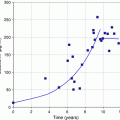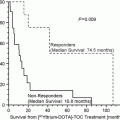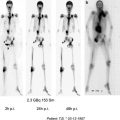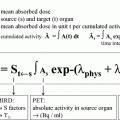Fig. 1
a Immunofluorescent labelling of γH2AX foci (green) of non-transformed human skin fibroblasts after 2 Gy irradiation and 4 h repair, b Countercoloration with DAPI (blue) (Courtesy of N. Foray)
4 Nuclear Medicine is Concerned
Nuclear medicine is concerned by the new radiation biology data in its two domains of activity, therapeutic and diagnostic nuclear medicine for dosimetric reasons. The doses delivered to the patients in nuclear medicine are large enough to produce DNA lesions which can be documented with modern radiation biology techniques. However there is a gap between such lesions and a possible health effect, i.e. the appearance of a cancer. Further research in oncogenesis is necessary to fill that gap.
It is assumed in this chapter that the radiation protection rules are strictly applied to the design and functioning of the nuclear medicine facilities in order to protect the workers. A special attention needs to be paid to the use of α emitters in order to avoid internal contaminations.
4.1 Therapeutic Nuclear Medicine
In therapeutic nuclear medicine, high doses of radiations are delivered to the tumours but also to normal tissues. Therapeutic nuclear medicine is a true radiotherapy indeed. Since the radiopharmaceuticals never target perfectly the tumours and only the tumours, deterministic side effects related to the irradiation of the organs at risk occur, e.g. bone marrow.
Progress needs to be made in the precise metrology of doses delivered to the tumours for at least the two following reasons. First, precise doses are necessary for the evaluation of the curative effect of therapeutic nuclear medicine and of the side effects. Second, precise doses are necessary for the evaluation of subsequent risks as a function of dose.
All these points have been developed extensively in other chapters of this book the reader is referred to (chapters by Sgouros, Stabin…).
Finally, bystander effects and genomic instability may be a concern in therapeutic nuclear medicine especially with the use of α emitters, e.g. 213Bi or 211As, but this needs to be further investigated.
4.2 Diagnostic Nuclear Medicine
In diagnostic nuclear medicine, low doses of radiation are delivered by the radiopharmaceuticals to both the target organs and to some non-target organs. The absorbed dose can range from a few mGy to hundreds of mGy. The effective dose for some of the most irradiating diagnostic nuclear medicine examinations range between 10 and 20 mSv. Thus nuclear medicine does not escape from the range of low doses where it is possible to document the biological effects of ionising radiation at the molecular and cellular levels.
5 Radiation Biology and Radiation Protection
Are new radiation biology findings going to change the radiation protection rules?
5.1 Risk Evaluation
International regulation in radiation protection results from the work of ICRU and UNSCEAR from which the recommendations of the ICRP and the basic safety standards of the international atomic energy agency (IAEA) are elaborated. In Europe, these recommendations are taken into account by the European commission for setting up new directives which are subsequently transcribed into the national regulations.
ICRP publication N° 79 (1998) focused on genetic susceptibility, i.e. radiosensitivity to cancer and mainly on the possible influence of this susceptibility on radiation protection in general. This important document stated in its conclusion that, for the general population, the number of cases of hypersensitive individuals do not lead to measurable distortion to population risk estimates. The present (severe) rules for radiation protection therefore do not need to be modified. However, the same document pointed out that “For the future, special consideration of the impact of susceptibility is likely to apply to the rise of radiations for therapy…”, and this for two rather obvious reasons: first, the high rate of hypersensitive cases (about 5 %) in a cancer patient population, and second, the high doses that should be delivered to cure malignant tumours (the dose levels being in these cases 1,000–10,000 times higher that those considered in current radioprotection).
In the most recent publication N°103 and N°105 published in 2007a, b, ICRP did not change position regarding the general rules of radiation protection. So far, no recommendation has been formulated regarding the potential risks of the non-targeted and delayed effects of ionising radiation including after radiation therapy. Consequently, the current project of future European directive on radiation protection does not address the issue of the impact of recent radiation biology findings.
5.2 Epidemiology
However, recurrent publications raise the issue of the number of cancers which will result from medical exposures despite their great medical benefits. The question comes from the large increase in the last years of the use of computerised tomography (CT), interventional radiology and positron emission tomography (TEP). In epidemiologic studies regarding CT (Smith-Bindman et al. 2009; Berrington de Gonzalez et al. 2009), although sophisticated risk projection models are used (BEIR 2005), the risk is finally close to the ICRP evaluation of a risk of 5 % per Sv in application of the LNT hypothesis.
It must be noticed that the risk is calculated and does not result from clinical observations. So far, descriptive epidemiologic studies have not demonstrated any stochastic effects resulting from medical diagnostic exposures to radiation. One can just say that medical exposures to radiation produce DNA lesions even at low doses. A cancer to appear requires a large number of DNA lesions still the subject of debate and the conjunction of many other factors such as genomic instability.
Furthermore, this type of calculation is based on the collective effective dose received by the patients. This is not a good use of the collective dose as it has been recently emphasised by ICRP (2007). The collective dose can be used to prepare an intervention also named planned exposure in order to split the dose into a large number of workers in application of the equity principle. The collective dose should not be used to evaluate an individual risk.
Thus the individual stochastic risk related to medical diagnostic exposures is not precisely known and in any case is low.
On another hand, secondary cancers are well-known features after radiation therapy (NIH 2006). The majority of second cancers occurring after radiotherapy appear in or close to the high dose treatment volume (Hall 2006) confirming the clinical experience. Clinical data also confirm the role of age with children being much more sensitive to the carcinogenic effect of ionising radiation than adults. A joint ICRP/ICRU document on the evaluation and management of secondary cancer risk in modern radiotherapy is still in progress to replace the previous ICRP recommendation n°44 of (1985).
5.3 New Questions and Ethics
Although it is not likely that the basic rules in radiation protection will be changed in the near future, they might need to be changed because of the individual sensitivity to radiation. Thus there is a series of questions which need to be addressed in order to confirm this hypothesis:
Which percentage of individuals in the general population and in cancer patients are somewhat “hypersensitive/hyposensitive” to radiation effects?
Should we identify systematically a priori these patients with a cancer in order to better plan their radiation therapy?
Should hypersensitive persons and cancer patients and their eventual siblings not be exposed or minimally exposed to radiations in order to prevent a first or a secondary cancer? Which counselling to perform?
May cancer cells have a different susceptibility to radiations from the susceptibility of the normal cells of the same patient?
What are the potential consequences of all issues stated above in terms of radiation protection rules?
The identification of genetic and epigenetic susceptibility to radiations is likely to develop more because it is needed to optimise radiation therapy. Genetic susceptibility to cancer is developing as well. Consequently the development of genetic testing already spreads to families of cancer patients, e.g. breast cancer families with a BRCA gene mutation.
Thus, further development of genetic testing might result in the possible discrimination of individuals due to their genetic characteristics. What should be feared from the development of this type of predictive medicine?
There is a global international consensus on a principle of non-genetic discrimination (UNESCO 1997). Genetic testing is permitted only for medical purpose or medical research. The person’s consent must be obtained in writing prior to the realisation of the test, and the person must be informed of the nature and the goal of the testing. Data must remain confidential at all times, i.e. their storage and restriction of access must be fully secured.
At work, medical investigations should be restricted only to the health status of the worker, and genetic testing can be used only to detect abnormalities due to the exposure to genotoxic agents; as an example, biological dosimetry assessed by cytogenetic testing is indicated for workers exposed accidentally to a high dose of ionising radiation.
5.4 Guidelines for Nuclear Oncologists
While waiting for the ideal approach for predictive diagnosis of individual susceptibility to radiations, (nuclear) oncologists are concerned with the following issues:
Do not ignore known hyper-radiosensitive syndromes, essentially ataxia telangiectasia homozygotes, Nijmegen breakage syndrome homozygotes and Fanconi anaemia patients, even if they are rare;
Beware of a few more frequent diseases, systemic sclerosis, Behcet’s disease, diabetes and other microvascular disorders with some degree of radiosensitivity;
Pay attention to a family history of cancers. Familial disorders predisposing to cancer could also predispose to radiation-induced second cancers and clinical hyper-radiosensitivity;
Stay updated, free articles. Join our Telegram channel

Full access? Get Clinical Tree








